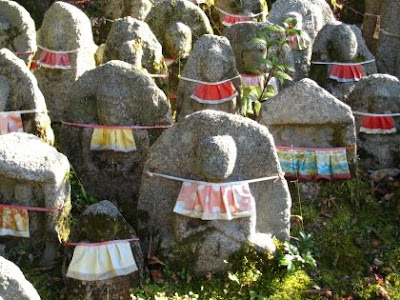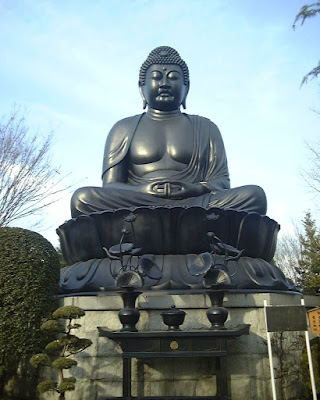We'll have a look at the komainu ("lion dogs") in the Yasui Konpira Shrine - but first some history.
There used to be a temple here (Rengeko-in) with as protection a shrine in its grounds that was a branch of the famous Konpira Shrine on Shikoku. The temple moved here in 1695 and at that time also the guardian shrine was set up. A development particular to the new shrine was that to Omononushi no kami, the original deity of the Konpira Shrine, two historical figures were added as gods: Minamoto Yorimasa and Emperor Sutoku, two people who had in fact been political enemies and whose drama had played out in this area.
[Yasui Konpira Shrine]
Emperor Sutoku (1119–64) was enthroned as a small child when the real power was in the hands of the so-called Retired Emperors, in this case his great-grandfather the former Emperor Shirakawa. He was forced to abdicate at an early time, as was not unusual, but then got involved in a scheme to have his own son succeed him. This failed, his half-brother became the new Emperor Go-Shirakawa. In 1156, Sutoku conspired to depose Go-Shirakawa in what historians call the "Hogen Disturbance," but he failed and was exiled to Sanuki Province (present-day Kagawa Prefecture), where he died.
Minamoto Yorimasa (1104-1180) was an aristocrat and military leader who stood on the side of Emperor Go-Shirakawa at that time, but here in the Yasui Konpira Shrine the deified souls of both enemies have been peacefully reunited, as the Japanese think should happen after death (or are they still kicking each other in the shrine's interior?).
In ancient Japan, angry and revengeful ghosts were greatly feared, and the dead Emperor Sutoku was thought to be able to cause havoc in the form of epidemics and sudden deaths. Therefore, to pacify his soul, a temple, Komyoin Kanshoji, was set up already in 1177 in this area where his residence had once been. His mausoleum also stands a few hundred meters to the north, at the back of the Gion Kaburenjo. This pious act must have helped, for we do not hear from him for quite a while, even when the temple was destroyed with the rest of Kyoto in the Onin Wars in the late 15th century. So when Rengekoin came newly to this site in the late 17th c., it took the precaution to honor the soul of the former Emperor - a continuation of a broken-off tradition - by deifying him in the Konpira Shrine. It is a long story, but history can be quite convoluted.
After the forced separation of Buddhism and Shinto in the early Meiji-period, the temple was destroyed and only the shrine survived. It is now famous for bringing lovers together (enmusubi) but also helping them separate again if so needed (engiri).
[The rock plastered with paper slips]
There is even a large rock in front of the main hall helping out with those wishes: write your name and that of the other person on a slip of Ofuda paper, crawl through the hole from back to front with the paper in your hand and then paste it on top of the others already plastered on the stone. Want to get rid of your partner? Do the same thing, only go through the rock from the front. Nothing could be easier - no wonder this used to be a popular shrine. And for those who cannot wait to consummate their new-found love, succor is nearby in the form of a street full of seedy love hotels, a monument to the efficacy of the deity of the Yasui Konpira Shrine.
[Love hotels near the shrine]
The present "cutting off" prayer in fact finds its origin in the story of Emperor Sutoku, who after coming to Shikoku visited the main Konpira Shrine, and prayed there for a kind of Buddhist liberation, a "cutting off" of all worldly desires. The shrine was popular among the women who worked in the nearby Gion entertainment district, who often came her to pray for the "cutting off" of relations with a good-for-nothing lover.
(The tunnel]
But now to the komainu. The Yasui Konpira Shrine has the honor to posses the oldest komainu in Kyoto, vintage 1767 - really not that old in years, and therefore a sign of the relative novelty of the custom of placing stone komainu in shrines.
There are three pairs of komainu in the shrine: the oldest ones stand near the north exit (where the love hotels are), in front of a small Tenmangu Shrine. The faces of these lion-dogs indeed have something uncouth, as if the sculptor is still trying to find the right style!
The other komainu of the shrine have been placed in front of the eastern gate (dating from 1857) and the southern gate (1844). These last ones are quite nice, especially the one with a small horn on its head.
[Horned komainu]
Information about Yasui Konpira's komainu was gleaned from Kyoto Komainu Meguri by Onodera Yoshiaki, Nakanishiya Shuppan, 1999 (one of the foremost authorities on komainu in Japan).





















